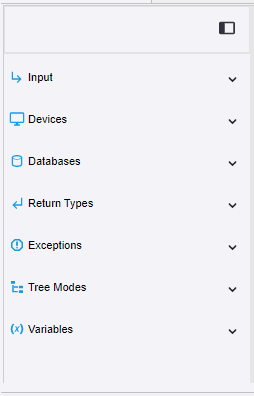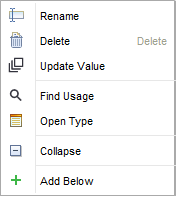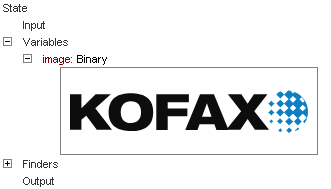Edit Robot
For information about editing a robot, see the following topics.
Editor
The Editor contains workflow and parameters such as variables, expressions, and tree mode settings.
Actions and navigation
-
Undock and move any of the Editor windows to make editing more convenient.
-
Pause or reset the execution of a robot.
-
Use buttons on the toolbar to navigate through the steps of a workflow.
-
Move forward in a workflow by using the Start Execution, Step Into, Step Over, and Step Out buttons.
-
Use the following key combinations to select multiple steps.
-
Shift+click selects a range of steps.
-
Ctrl+click adds or removes a selection of steps.
-
Ctrl+Shift+click adds a range of step selections.
-
Toolbar buttons
For a list of robot buttons, see Toolbar.
Zoom in and out of Editor
Zoom in and out of the workflow view the same way you zoom in a web browser.
-
To zoom in, press Ctrl+ (plus sign) or Ctrl+mouse wheel scroll up.
-
To zoom out, press Ctrl- (minus sign) or Ctrl+mouse wheel scroll down.
Robot definitions
Use the toolbar, Robot definitions pane, and context menu to add, configure, and modify the following robot definitions.
-
Input: View input parameter definitions that a robot takes, including test values.
-
Devices: Define the required devices that a robot uses.
-
Databases: Define the required database mappings that a robot uses.
-
Return Types: View lists of return types that a Robot delivers to a Basic Engine Robot.
-
Exceptions: View exceptions that may occur.
-
Tree Modes: Configure the application-tree type for different applications to deliver.
-
Variables: Configure Robot variables.
Toolbar and pane
Click the
![]() icon to collapse or expand the view from a toolbar to a pane of Robot
definitions. Each view lists the definition areas in the same order.
icon to collapse or expand the view from a toolbar to a pane of Robot
definitions. Each view lists the definition areas in the same order.
-
Click an icon in the Robot definitions toolbar to go directly to the corresponding definition area.
-
Click the up and down caret marks to expand and collapse each definition and related elements. The caret mark must be up to add and view definitions and to access Kofax RPA Help topics by clicking the ? symbol to go directly to the related topic.
-
If an area has definitions, a green plus sign
 appears after the existing definitions. Click the green plus sign to add
definitions.
appears after the existing definitions. Click the green plus sign to add
definitions.
-
If an area has no definitions, a message appears such as "No devices available" followed by a button, such as
 . Click the button to add the first definition.
. Click the button to add the first definition.
The following images show the Robot definitions toolbar, pane, and expanded areas where definitions are added and edited.

|

|
Context menu
Right-click within a definition, parameter, or the Robot definitions pane to view the context menu.
The options vary based on where you right-click.
The following example shows how the menu appears for an input parameter with a Record type.

The following table lists all context-menu options, with explanations of when options are available.
|
Button |
Tooltip |
Description |
|---|---|---|
|
Rename |
Renames the selected element. |
|

|
Delete |
Deletes the selected element. The Delete option is available in all but the Exceptions area. |
|
Update Value |
Updates values for a Record value and is only active if the value type has changed since the value was last edited. |
|
|
Find Usage |
For Input, Devices, and Variables, use the Find Usage feature to find where they are used. This option is similar to the text search, except that the list in the Search Result panel only shows instances of a specific element. |
|
|
Open Type |
Opens a type in the Design Studio Type Editor. Opens the type from parameter or variable definitions. Open Type is available on Input and Variable definitions and on Return Types. See Types. |
|
|
|
Select in My Projects View |
Selects (finds) the corresponding mapping file in the My Projects view so that you can edit the file by double-clicking on it in the My Projects view. This option is available on Devices and Databases definitions. |
|
|
Expand |
Expands fields and entries in the active definition. |
|
Collapse |
Collapses fields and open entries for the selected element. |
|
|
Add |
Adds a new element. Based on the definition, this right-click option displays text that matches. Examples: Add Input, Add Device, and Add Database. |
|
|
Add Below |
Adds a new element below the current selection. The Add Below option is available in all but the Exceptions area. |
Recorder View
Shows tabs with open application windows and a tree with available elements. Either select elements in the interface or select images and insert steps by right-clicking the selected element or image.
The view shows the live streaming status of the device state. See also application-level actions.
Recorder View toolbar
|
Button |
Rollover Text |
Description |
|---|---|---|
|
|
Pauses or resumes live streaming of the device state. Click to pause or resume streaming in the Recorder View. |
|
|
|
Create finder for selection |
Creates a finder for the selected element in the Recorder View and replaces the selected finder in the robot. It is only enabled if the selected finder is on the step immediately after the current flow point. |
|
|
Show next location found |
Shows the next element that matches the finder. The tooltip displays the number of matched elements. |
|
|
Select Next Node Matching Click |
Moves selection to the next node that matches the selection in the Recorder View. |
|
|
Select zoom level |
Zooms in and out in the Recorder View. |
|
|
Select Tag One Level Out |
Changes selection to the node, which is the parent to the selected one. |
|
|
Select Tag One Level In |
Selects the first child node of the selection. |
|
|
Select Outermost Tag |
Changes selection to the top node in the application tree. |
|
|
Select Innermost Tag |
Selects the last child node of the selection. |
|
|
Select Previous Sibling Node |
Selects the previous node located on the same level in the application tree. |
|
|
Select Next Sibling Node |
Selects the next node located on the same level in the application tree. |
|
|
Copy Sub Tree As XML |
Copies the subtree element selected in the tree view. |
|
|
Immediately executes a step inserted from the Recorder View. Prior to adding a step or a multiple steps, click this button. If a step opens a new application or a dialog, a respective tab appears in the stream view and becomes the active tab. To stop automatic execution, click this button again. |
Coordinates
The bottom of the Recorder View shows the coordinates of the mouse relative to the top of the application window.
When you select an element in the view, it shows the coordinates relative to the top of the selected element and the path to the element in the bottom bar.
| Color | Description |
|---|---|

|
Shows the mouse coordinates relative to the top-left corner of the window. |

|
If you select a purple area, the figure next to the purple box indicates the displacement of the mouse relative to the top-left corner of the purple area. While an area on an image is being selected to use the image finder, shows the size of the purple area in pixels. |

|
When you click an element in the tree or on an image, this shows the displacement of the mouse in pixels relative to the top-left corner of the green area. |

|
When you click an element in the tree, this shows the displacement of the mouse in pixels that is relative to the top-left corner of the orange area. |

|
When a robot contains a loop, this option indicates the parent element that contains the loop and the element that the loop is currently on. |
Tags are marked with colored boxes corresponding to their current state:
All tag paths in the Recorder View are interactive.
Switch between elements
To switch among elements of different levels, use the following buttons:
- Select Outermost Tag
- Select Tag One Level In
- Select Tag One Level Out
- Select Innermost Tag
- Select Previous Sibling Node
- Select Next Sibling Node
Sometimes it is not possible to select cell elements in tables in the application view. In these cases, select cell elements in the application tree and add steps from the tree view.
Zoom in and out of Recorder View
Zoom in and out in the Recorder View either by selecting a zoom level on the toolbar or in the same way you would in a web browser.
-
To zoom in, press Ctrl+ (plus sign) or mouse wheel scroll up.
-
To zoom out, press Ctrl- (minus sign) or mouse wheel scroll down.
Application-level actions
Application-level actions are actions applied to the entire application and available by right-clicking the application tab in the Recorder View. These include the following actions and steps.
-
Application Action
-
Focus: This action is available for remote desktop applications.
-
For locally running applications such as Excel, Document Transformation Browser, website browser, and terminal emulators, the list of application actions varies. See related topics for details.
-
Search results
Displays an overview of Search results.
Comment
Shows comments for selectable items in the automation workflow such as steps, Group steps, variables, finders, input types, conditional branches, and so on.
To write or change a comment, click an item and add or change notes in the Comment window. Use the Undo and Redo buttons here. The comment is automatically saved when you click outside the window.
An item that contains a comment is marked with a comment sign.
State
Shows the state of the workflow execution and included elements such as input, variables, finders, databases, return values, and output values. See also State Pane and Data State Pane.
Provides context sensitive pop-up menus. Use the pop-up menu options to insert steps, which are automatically configured using information from the element you click. This option is faster and more efficient than manually entering and configuring steps.
Also, right-click an entry or field in the State pane to view pop-up menu options to perform the following tasks:
-
Copy a value.
-
Paste a value.
The paste option is especially useful for binary values because these cannot be changed via the Set Value option. See also "Clear a value."
-
Set a value.
-
Clear a value
The Clear option is useful for clearing a binary field before pasting in a new binary value. In the empty binary field, paste the binary item that you copied to the clipboard.
-
Collapse all open fields or elements for the selected item.
To collapse all elements in the pane, right-click State and select Collapse All.
-
Insert the following steps: (See also Steps.)
-
Assign To
-
Convert
-
Store in Database, Find In Database, or Delete From Database
-
Calculate Key
-
Output Value for a variable of Record type
For example, right-click a variable, select Insert Step > Output, and execute the Output Value step. The result appears under the output values in the State pane.
-
-
Temporarily change a variable or input value.
This option is useful for advanced robot programmers to use while debugging. See details that follow.
To temporarily change a variable or an input value field:
-
Open a text field for the value by either double-clicking the value or placing the pointer on the value and selecting Set Value from the pop-up menu.
-
Type the new value.
The value must be a text entry that represents a valid entry for the element. For example, either true or false is required for a Boolean value.
-
To commit the change, press Enter.
If you click outside the text field without pressing Enter, the field closes without changing the value. (The value reverts to the original value.)
The temporary changes remain in effect until either the value is changed by the robot or the execution is reset.
When
Kofax RPA
detects that a binary variable contains an image, the image is displayed in the view.
Kofax RPA
detects GIF, JPEG, BMP, TIFF, and PNG images. The image tooltip shows the MIME type of the image and its size (width and
height).

Output log
Contains workflow execution messages.
Tips
- Put focus on errors in workflow
- When a step is inserted from a flow point in the robot and that step contains an error or multiple errors, the location of the first error is indicated in the expanded step. If the robot execution is stopped due to errors in a step, that step is expanded to show the location of the first error. If any steps were inserted in the workflow using "Surround with" steps, those steps are expanded.
- Make instant mouse clicks that are not recorded
-
Perform an instant mouse click on an element without adding it to the robot workflow. This action can be useful to close an unnecessary or accidentally opened tab. Right-click an element in the Recorder View, click Unrecorded Instant Click, and select the mouse click type to use.
- Close built-in applications
- Close application tabs of built-in applications such as Browser, Excel, and others while editing a robot by clicking the Close button in the top-right corner of the tab. This action is not a step, and the tab closes like any window.



 .
.
 .
.




